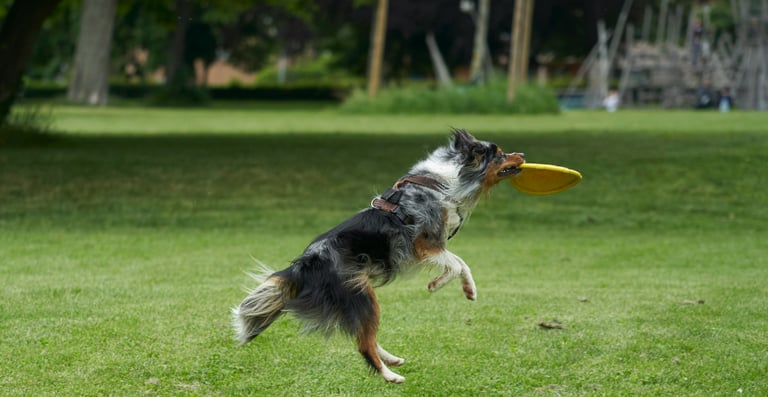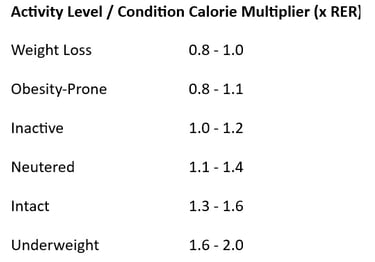How to Easily Identify Your Dog's Calorie Needs (And Why It Matters)
Feeding your dog the right amount of calories isn't just about keeping their weight in check—it's about boosting their health, energy levels, and lifespan. When switching your furry friend to a fresh, homemade diet, figuring out their calorie needs can feel overwhelming—but it doesn't have to be.
3/24/20253 min read


How to Easily Identify Your Dog's Calorie Needs (And Why It Matters)
Feeding your dog the right amount of calories isn't just about keeping their weight in check—it's about boosting their health, energy levels, and lifespan. When switching your furry friend to a fresh, homemade diet, figuring out their calorie needs can feel overwhelming—but it doesn't have to be.
Here’s a simple breakdown of everything you need to know to nail your dog's daily calorie requirements.
First, the Key Terms You Need to Know
Calories: The energy your dog gets from food, powering everything from chasing squirrels to snoozing on the sofa.
Resting Energy Requirement (RER): The baseline calories your dog needs just for basic bodily functions (think breathing, heartbeat, and digestion) when they're relaxed and not fasting.
Daily Energy Requirement (DER): Total calories your dog needs daily, including RER plus extra calories for activities, life stage changes, and environmental factors.
Body Condition Score (BCS): A simple numeric system used to quickly gauge whether your dog is underweight, ideal, overweight, or obese.
Activity Duration & Intensity: How long and how vigorously your dog exercises each day—both influence calorie requirements significantly.
The 8 Key Factors That Influence Your Dog's Calorie Needs
When determining calorie intake, a "one-size-fits-all" formula simply doesn't cut it. Here's what truly matters:
Body Condition Score (BCS):
Underweight: Needs more calories. First, check with a vet to rule out medical issues, then gradually increase calories.
Ideal Weight: Keep current calorie levels steady, but monitor when switching to fresh food, as your dog might need more.
Overweight & Obese: Reduce calories carefully and increase gentle exercise. Switching from high-carb commercial foods to fresh, lower-carb diets can help shed pounds naturally.
Activity Level:
Sedentary (0-30 min/day): Minimal calories required.
Low Activity (30 min-1 hour/day): Slight calorie increase.
Moderate Activity (1-2 hours/day): Moderate calorie needs.
High Activity (2-3 hours/day): Significant calorie boost needed.
Working Dogs (3+ hours/day): High calorie needs; may require 2-5x RER.
Note: Not all activities are equal—a 30-minute run burns far more energy than a leisurely walk!
Breed Size & Genetics:
Some breeds like Labradors, Bulldogs, and Beagles pack on pounds easily and may need fewer calories.
Arctic breeds (like Huskies) may naturally require fewer calories despite high activity levels.
Life Stage:
Younger dogs burn more calories due to higher metabolism and activity levels.
Senior dogs (over 7 years) typically need about 10-20% fewer calories than adults aged 3-7 years.
Reproductive Status:
Spayed/neutered dogs have a significantly increased risk of weight gain. Adjust calories downwards slightly and boost physical activity.
Climate:
Dogs in colder climates need more calories to maintain body temperature. The colder it gets, the more energy required—especially for shorter-haired breeds.
Medical Conditions:
Injuries or illnesses that reduce activity will require fewer calories, whereas some conditions or medications may increase appetite, demanding higher caloric intake.
Individual Metabolism:
Ultimately, every dog is unique. Even with the same factors, two dogs can have entirely different calorie needs.
Simplified Guide: Adjusted Calorie Multipliers
Here's a helpful chart to give you a starting point:
Note: Multipliers are applicable for adult dogs aged 12-18 months and older.
The Easiest Method: Start With What You Already Know
The simplest way to get started? Check your dog's current diet. Whether it's dry, canned, or raw food, packaging typically lists calorie content clearly. Observe how your dog’s body responds:
Maintaining an ideal weight? Stick to current calories as a baseline.
Losing or gaining weight? Gradually adjust intake accordingly.
Your Next Step
Calorie counting doesn't have to be intimidating—it's a flexible process. By simply paying attention to your dog's unique condition and adjusting accordingly, you'll easily find the sweet spot that keeps your furry friend happy, healthy, and energetic.


